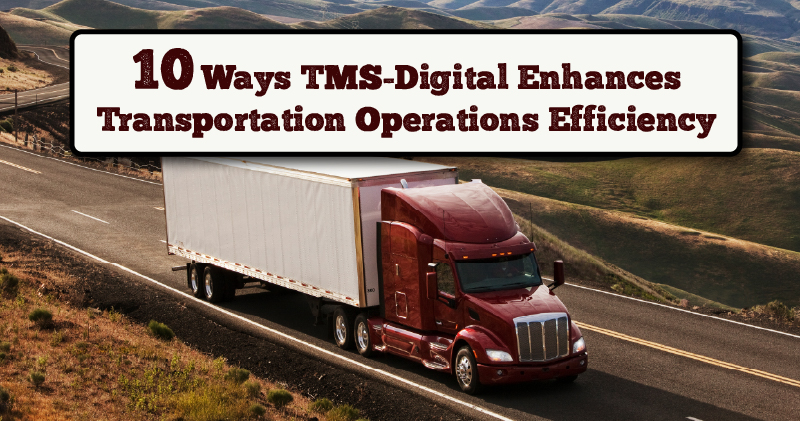
As a leader in the transportation industry, you continually seek methods to enhance efficiency and streamline costs. One of the most potent tools at your disposal is the Transportation Management System (TMS). This technology can significantly reduce turnaround time (TAT) and the total distance your fleet covers. With the TMS market poised to exceed $180 million by 2035, integrating TMS into your trucking operations becomes imperative for staying competitive. In this blog we’ll learn 10 ways TMS-Digital enhances transportation operations efficiency.
Here are Ten Ways TMS-Digital Can Revolutionize Your Transportation Operations with Practical Examples:
- Dynamic Routing: Dynamic routing adapts routes in real time based on traffic conditions and unforeseen events. TMS-Digital, utilizes real-time data to ensure drivers always take the quickest path to their destination, avoiding delays caused by accidents or congestion.
Example: Picture a scenario where a truck is en route to deliver goods in a bustling urban area. Suddenly, a major traffic jam occurs due to an accident. TMS-Digital swiftly reroutes the truck, suggesting an alternative path that reduces travel time by 20 minutes, ensuring timely delivery and minimizing fuel consumption.
- Automated Scheduling: Automated scheduling plans the most efficient sequence of stops for each vehicle, prioritizing time-sensitive deliveries. TMS-Digital intelligently schedules deliveries, ensuring urgent shipments are prioritized automatically.
Example: Suppose your company needs to deliver perishable goods like flowers to multiple locations. TMS-Digital schedules these deliveries early, reserving later slots for less time-sensitive deliveries like office supplies. This maintains freshness and reduces time spent on the road.
- Predictive Analysis: Predictive analysis forecasts future conditions using historical data, aiding in preparing for regular patterns or traffic conditions. TMS-Digital analyzes historical data to predict potential delays, enabling better preparation for future challenges.
Example: By analyzing past data, TMS-Digital identifies heavy traffic near tourist spots on Friday afternoons during summer. Armed with this insight, you can adjust schedules to avoid these routes or dispatch deliveries earlier.
- Load Optimization: Optimizing load ensures each trip is as efficient as possible, reducing the number of trips needed. TMS-Digital maximizes vehicle capacity utilization, saving fuel and reducing unnecessary trips.
Example: If delivering books to schools and libraries, TMS-Digital plans each vehicle’s load to maximize capacity without exceeding weight limits. This consolidation reduces trips and total distance traveled.
- Geofencing: Geofencing creates virtual boundaries triggering alerts when vehicles enter or exit specific areas, aiding in monitoring and managing activities effectively.
Example: Setting up a geofence around a city center alerts you when a truck enters high-traffic zones, allowing route adjustments to avoid congestion during peak hours.
 Auto Order Allocation: This feature assigns orders to drivers based on proximity and vehicle capacity, optimizing delivery times and fuel consumption.
Auto Order Allocation: This feature assigns orders to drivers based on proximity and vehicle capacity, optimizing delivery times and fuel consumption.
Example: A last-minute order can be instantly assigned to the nearest driver with sufficient cargo space, maximizing efficiency and responsiveness.
- Territory Management: Dividing service areas into zones ensures deliveries are evenly distributed among drivers and vehicles, enhancing efficiency.
Example: Assigning drivers to specific territories based on familiarity reduces travel times between deliveries and improves service quality.
- Capacity Planning: Analyzing vehicle capacity and planning load accordingly maximizes trip efficiency.
Example: Switching to smaller vehicles for routes with consistently unused space optimizes fuel usage and reduces operational costs.
- Order Batching: Grouping orders headed to nearby destinations reduces the trips required.
Example: Batching deliveries to the same neighborhood minimizes driving time and fuel consumption.
- Driver Preferences and Constraints: Consideration of driver preferences and constraints improves scheduling and compliance.
Example: Accommodating preferred working hours increases driver satisfaction and optimizes route planning.
Conclusion
TMS-Digital offers a comprehensive solution for enhancing transportation operations efficiency. By leveraging dynamic routing, automated scheduling, and predictive analysis, TMS-Digital optimizes routes, reduces fuel consumption, and ensures timely deliveries. Incorporating features like geofencing and auto order allocation further streamlines operations, while considering driver preferences enhances job satisfaction and compliance. With TMS-Digital, operational managers gain a powerful tool to meet business goals efficiently and effectively.
Ready to revolutionize your transportation operations? Click here to learn more about TMS-Digital and streamline your logistics today!









